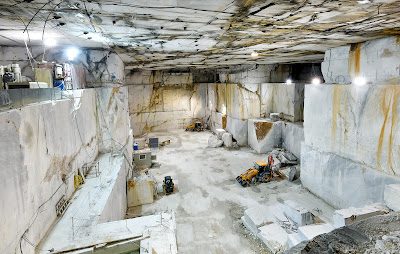 |
| Large excavator inside a Carrara marble quarry |
The name "Calacatta" is associated with a particular type of marble that is quarried in the Carrara region of Italy, specifically from the Apuan Alps. This marble has a distinctive white background with bold, dark gray veining. The beauty and rarity of this marble have made it a sought-after material for centuries.
However, the cost of natural marble can be prohibitive for some homeowners, which has led to the rise of Calacatta quartz - an engineered stone that imitates the look of natural marble at a fraction of the cost. In this article, we'll explore the differences between Calacatta quartz and Calacatta marble, and consider the pros and cons of each.
 |
| Inside a mountain shaft in a Carrara marble mine |
Cost Savings
The most significant advantage of Calacatta quartz is its cost. While the price of natural marble varies depending on the grade and quality, it is generally much more expensive than quartz. On average, Calacatta marble can cost far more than $250 per square foot, while Calacatta quartz can easily cut that cost in half. The price difference is primarily due to the manufacturing process and the availability of the materials. Calacatta marble is a natural stone that must be quarried and transported, while Calacatta quartz is an engineered stone made from crushed quartz and resin, which is produced in a factory. The cost savings of Calacatta quartz make it an attractive option for those who want the look of marble without the price tag.
 |
| Industrial machinery in an open-cast marble quarry |
 |
| Aerial view of an area used as a marble warehouse awaiting processing |
The Look
When it comes to appearance, both Calacatta quartz and Calacatta marble offer a similar look. Both materials feature a white background with grey veins, although the pattern can vary depending on the grade and quality of the natural marble. However, there are a few differences that set the two materials apart. Calacatta marble has a natural variation in colour and veining, which gives it a unique and distinctive look. In contrast, Calacatta quartz is a uniform colour and pattern, which may not appeal to those who prefer the organic and varied look of natural stone. Additionally, Calacatta marble has a more natural feel and texture than Calacatta quartz, which can have a slightly artificial appearance.
The Imitation
One of the main criticisms of Calacatta quartz is that it is an imitation of natural stone. While it can mimic the appearance of marble, it does not have the same depth, character, and organic nature as natural marble. However, for many homeowners, the benefits of Calacatta quartz outweigh the negatives. It is a durable, low-maintenance material that is less prone to staining and chipping than natural marble. Additionally, because it is an engineered stone, it can be produced in larger slabs than natural marble, which can reduce the number of seams on a countertop or surface. This can be particularly appealing for those who want a seamless and uniform look.
 |
| Colourful mosaic of different types of Italian marble |
Why So Many Variations?
 |
| A slab of Calacatta Maxima by Omnia. Engineered quartz that is great at mimicking marble. |
Timeless Marble on a Budget
Ultimately, the choice between Calacatta quartz and Calacatta marble comes down to personal preference and budget. For those who prioritize the organic and natural look of marble, and are willing to pay a premium for it, natural marble is the way to go. However, for those who want the look of marble without the high cost and maintenance, Calacatta quartz is an excellent alternative. It offers a durable and low-maintenance surface that imitates the look of natural marble while being more affordable and accessible. Whether you choose natural marble or engineered quartz, Calacatta remains a timeless and luxurious choice for any home.
